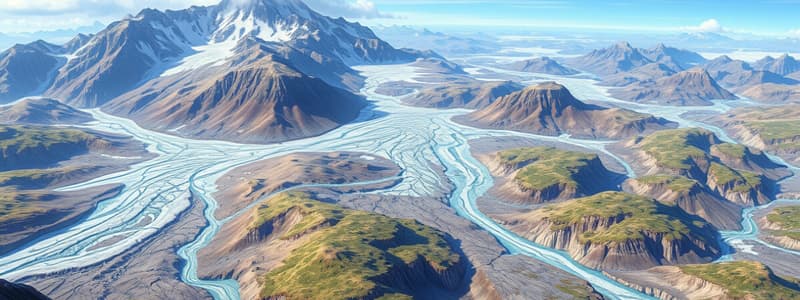Podcast
Questions and Answers
What percentage of Earth's freshwater is stored in glaciers?
What percentage of Earth's freshwater is stored in glaciers?
- 75% (correct)
- 50%
- 68%
- 90%
What is the main component that forms glaciers?
What is the main component that forms glaciers?
- Permafrost
- Meltwater
- Accumulated snow (correct)
- Frozen seawater
Which of the following components does not contribute to glacier formation?
Which of the following components does not contribute to glacier formation?
- Snowfall
- Accumulation of dirt and rocks
- Melting ice
- Seawater freezing (correct)
How thick can glaciers become?
How thick can glaciers become?
Which statement about the cryosphere is true?
Which statement about the cryosphere is true?
What type of crystal structure is most common in ice?
What type of crystal structure is most common in ice?
Which of the following statements best describes glaciers?
Which of the following statements best describes glaciers?
What happens to snow when it accumulates over time?
What happens to snow when it accumulates over time?
Flashcards are hidden until you start studying
Study Notes
Glacier Formation
- Glaciers are significant masses of snow and ice formed from accumulated snowfall over time.
- Thickness of glaciers can vary greatly, from a few dozen meters to over 2 kilometers.
- Formation occurs when unmelted snow accumulates, compressing to create dense glacial ice.
- All glaciers start on land and can flow into oceans, differing from sea ice, which forms from seawater freezing.
Characteristics of Glaciers
- Glaciers are immense bodies of ice, often weighing several gigatons.
- They shape unique landscapes by leaving behind various landforms.
- The movement of glaciers is driven by the accumulation of snow and ice that exceeds melting and evaporation rates.
- The weight of accumulated snow exerts pressure, converting it to ice and transporting debris like dirt, gravel, and rocks.
Glacier Statistics
- Approximately 68.7% of glaciers consist of freshwater and ice caps, with estimates ranging from 68% to 75%.
- Around 75% of Earth's freshwater is stored in glaciers.
- Glaciers cover about 10% of the Earth's total land area.
Ice Properties
- Glacial ice possesses the highest density among ice forms, although seawater is denser but not part of glacial formations.
- The cryosphere refers to the portion of Earth that is perpetually frozen, including freshwater, saltwater, and ground, excluding clouds.
Ice Crystal Structures
- Ice has a hexagonal crystal structure (IH), which is the most common crystalline form.
- Another form of crystalline ice (IC) is created by depositing vapor at extremely low temperatures.
Studying That Suits You
Use AI to generate personalized quizzes and flashcards to suit your learning preferences.





